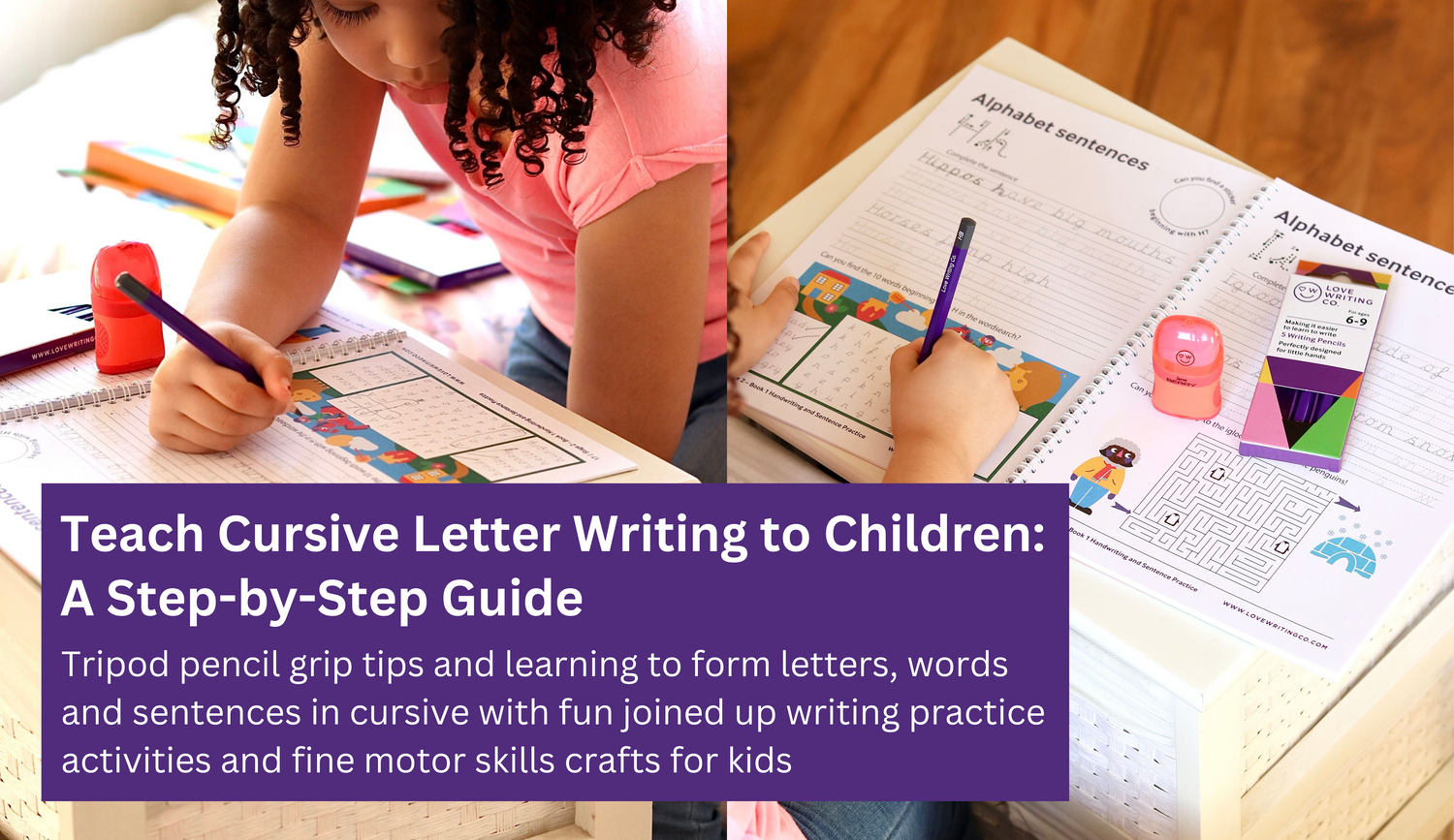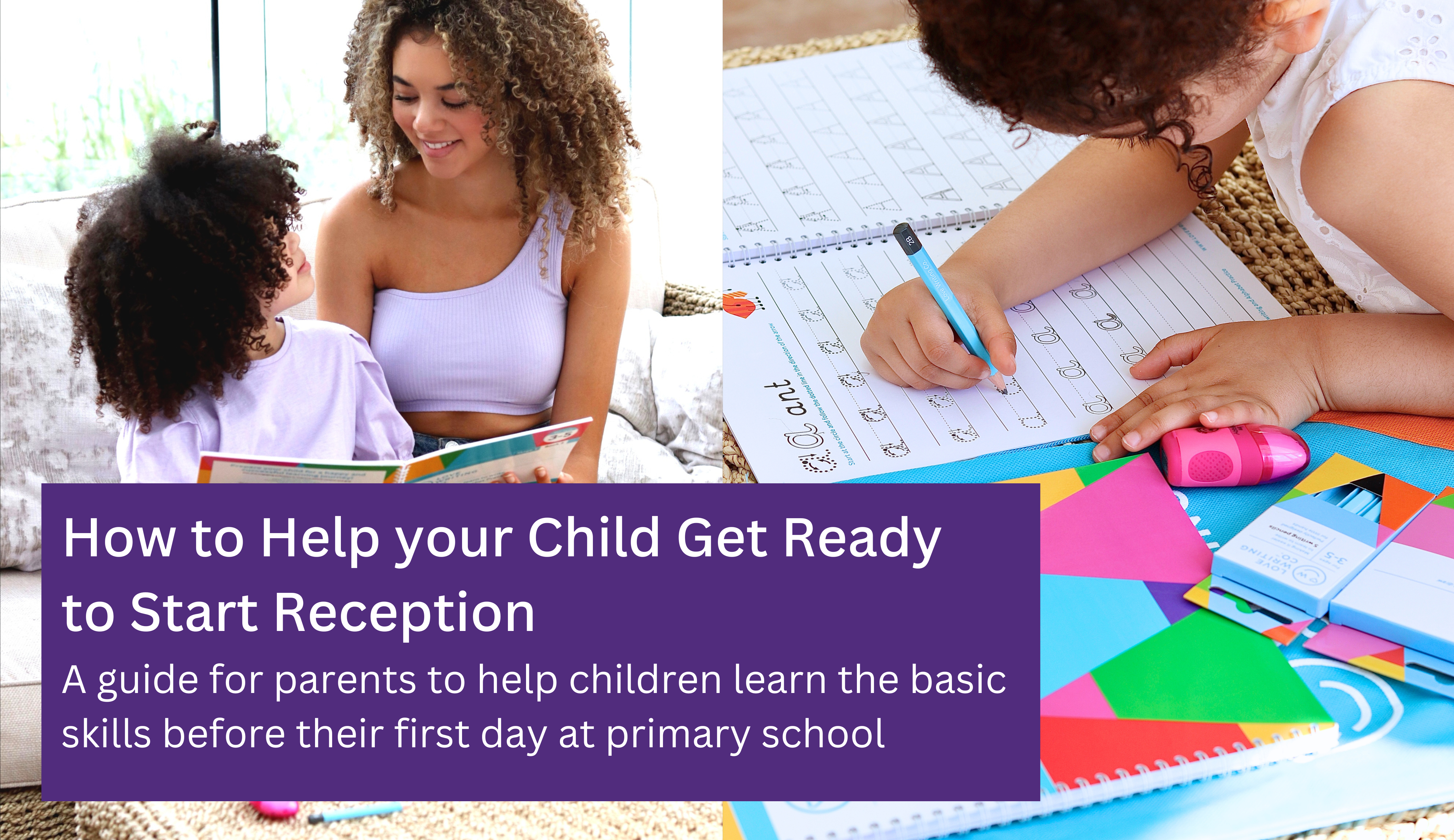In this blog, we explore some fun ways to help learn joined up handwriting skills, master letter formation and build fine motor skills through cursive handwriting practice ideas and tracing activities.
Teaching your child good letter formation skills and cursive handwriting can be tricky, but there are so many fun handwriting activities and easy step-by-step cursive writing practice ideas that will help your child achieve good and confident handwriting skills all whilst having fun.
Writing in cursive helps improve fine motor skills, reinforces spelling, reading and faster writing.
Supporting your child’s early literacy skills fosters good writing habits from the start and helps to increase concentration and think more carefully when forming letters and taking notes, setting them up for a successful learning to write journey and academic success!
Shop cursive handwriting resources at www.lovewritingco.com perfect for ages 6-9.
Simple but effective - Make it fun
Before putting pencil to paper, explain to your child why learning to write in cursive is important (it helps with their hand muscles, is a really cool and neat way to write and is naturally the next step many children are taught in school at this age). Make the reasons exciting so that they want to give it a go!
Talk about how it was used in important letters long ago, or how they’ll be able to sign their name beautifully.
Try fun sensory activities and letter flashcards to help boost motivation and curiosity. Use a sensory tray using different textures such as sand, shaving foam or crushed up cereal (this is a great idea as it is safe and yummy to eat) and ask your child to practice tracing their cursive letters.
You can also use flashcards to help them copy and trace each letter and build letter recognition and writing confidence.
Introduce Cursive Letters in a specific order
Instead of teaching letters alphabetically, group them by similar strokes. This helps children learn more efficiently and is a common way children are taught.
Learning cursive also helps children avoid mixing up tricky letters like ‘d’ and ‘b’ and helps them learn to recognise different letters more easily and in turn write them more quickly. Start with lowercase letters then move on to uppercase letters.
A common progression looks like this:
Group 1: Easy curves – c, a, d, g, o, q
Group 2: Loops and upstrokes – i, u, w, t, e, l, b, h, k
Group 3: Connecting curves – n, m, v, x, y, z
Group 4: Unique forms – j, f, r, s, p
If you're looking for resources to support their cursive writing practice, why not try our NEW Next Cursive Steps Bundle for Kids Ages 6,8,7 and 9 years olds to help them reach their targets and practice cursive handwriting at home with ease and confidence.
Our cursive workbook has been specially designed by educational experts to support cursive pencil grip and control, letter and word formation and practice cursive sentence writing. This 57 page activity book compliments the National Curriculum and introduces cursive in an enjoyable way.
- 57 Pages and 35 Reward Stickers
- Cursive word and letter formation practice
- Learn to write the days of the week, months of the year and seasons.
- Focused cursive pencil grip and control activities
- Build cursive confidence and handwriting ability
- Word searches, puzzles, mazes and full of fun activities.
- Perfect for right and left-handers learning to write
- SEND friendly handwriting resources
- Numbers, letters, phonics practice and more
Using the Correct Tripod Pencil Grip
Good handwriting starts with making good writing habits from the very start through early learning and pencil grip practice.
Demonstrate how to hold a pencil correctly using the tripod grip (we have some blogs on this to help with tripod grip if you'd like to take a look).
When learning to write, it is important to use the correct tools they need to have a positive writing journey from the get go. By Using incorrect tools that are uncomfortable for a child's hand can distract them from the task at hand and affect their attitude towards learning. Remember - pencils that are too big for their hands may be the reason they are experiencing discomfort and finding it hard to form letters.
Our writing tools support a comfortable writing experience with pencils scaled to fit a child's hand. Try out Tripod Grip Writing Pencils for Kids Ages 6, 7, 8 and 9 years old to help master the correct tripod grip with ease. Designed to be the correct length for children aged 6-9 and with a wider diameter, softer core and hexagonal shape, our pencils prevent muscle fatigue and encourage the correct tripod grip, promoting a love of writing from an early age.
Tripod Grip Writing Pencils - available to purchase here ages 2-9 www.lovewritingco.com
Good, relaxing writing environments
Create a learning environment at home that consists of a quiet area to read and a desk and chair where your child can sit and practice writing comfortably. Comfort is key to the correct body positioning needed for handwriting.
Use Letter Tracing Activity Sheets
Try worksheets with dotted or highlighted cursive letters so they can trace first. Large-letter tracing (with arrows showing direction) is helpful in the beginning.
All of our cursive resources have step-by-step directional flow - check out our workbooks here.
You can also write letters yourself on a piece of paper very faintly or with dotted lines and let your child trace over them before trying it on their own.
We have lots of free activity sheets you can download here: Free Sheets
Practice Connecting Cursive Letters
Once your child is comfortable with individual letters, introduce simple two-letter combinations or “letter bridges,”.
Practice phonics, digraphs and vowels through letter formation practice like ar, ou, ee, th. These help ease the transition to writing full words whilst also improving reading, spelling and early literacy skills.
Writing Short Words and Simple Sentences
Practice common, simple high frequency words like “the”, “and” or “but” — try tracing words that are meaningful to your child, like their name, "mom," "dad," "dog," or "fun."
Encourage writing short sentences with positive affirmations like: “I am happy” or “I am kind”. Remember to keep it light and enjoyable—no pressure!
Handwriting skills are more successful when practicing little but often, just 5,10 or 15 minutes a day can make all the difference.
Let’s get Creative!
Make cursive more fun by combining it with drawing or crafts.
Let them write labels for their artwork in cursive or decorate their name for a bedroom door sign with colourful swirls and designs. This helps them take pride in their writing and feel a sense of accomplishment!
Learning through creativity increases engagement, enthusiasm to learning and curiosity. Here are some fun cursive writing activities that you can try:
Cursive Name Banner: Have kids write their names in large cursive letters on separate pennant-shaped pieces. Decorate each letter with stickers, glitter, or drawings. String them together into a banner.
Cursive Watercolour Art: Paint a colourful abstract or gradient background. Once dry, write a favourite quote or word in cursive over it. Frame or hang it up!
Cursive Salt Writing: Write words in cursive with PVA glue on the paper. Sprinkle salt over the glue. Once it dries a little, use watercolour paints and lightly touch the salt to create a fun tie-dye effect.
Cursive Word Rocks: Paint or write positive affirmation words (like “joy,” “hope,” “love”) in cursive on smooth stones. Use them as decorations or gifts
Cursive Pavement Chalk Art: Head outside and write large cursive words on the sidewalk. Add drawings and borders for a fun mural effect.
Teaching cursive writing is a journey filled with flicks, ticks, and lots of smiles. With patience, praise, and a bit of play, your child can develop a beautiful writing skill that stays with them for life.
And that's a wrap, thank you so much for reading! We hope you take from this some useful tips and creative ideas to help your child master the proper tripod pencil grip and master cursive writing in a fun and engaging way.
Check out our free phonics guide, alphabet sounds and blogs and advice for more useful tips and tricks to help your child build good writing habits from the start that will last them a lifetime!
Happy Writing! ❤️✏️
From Love Writing Co.
Shop Handwriting and Alphabet Practice Workbooks - Cursive and Pre-Cursive handwriting practice books for children that complement the UK National School Curriculum | SENDfriendly special educational needs resources for children | lay-flat format is ideal for right or left-handed handwriting practice
Shop Tripod Grip Writing Tools - Small, chunky, hexagonal fine motor tripod grip writing pencils. Designed to be the correct length for little hands and with a wider diameter, softer core and hexagonal shape, our pencils prevent muscle fatigue and encourage the correct tripod grip, promoting a love of writing from an early age.
Shop Printable Handwriting Activity Worksheet Packs for Kids - Pre-Cursive and Cursive handwriting practice sheets and fun wordsearch, maze and pencil control activities for children ages 2-9 years old. Perfect activity sheets and workbooks for fun learning at home, holidays and useful print on demand.
Cursive Writing Practice Packs for Left-handed Children - We believe that learning to write should be easy and accessible to all children so our products are all right and left-handed friendly with a ring-bound and lay-flat design with no ‘bump’ in the middle.
SENDfriendly Writing Practice Resources for Kids - SEND friendly approved writing and early learning resources all follow the UK National school curriculum which is perfect for both home-learning and in the classroom. Our handwriting practice sets support fine motor skills, cognitive perception, memory retention through guided letter practice and fun activities.







Leave a comment
All comments are moderated before being published.
This site is protected by hCaptcha and the hCaptcha Privacy Policy and Terms of Service apply.